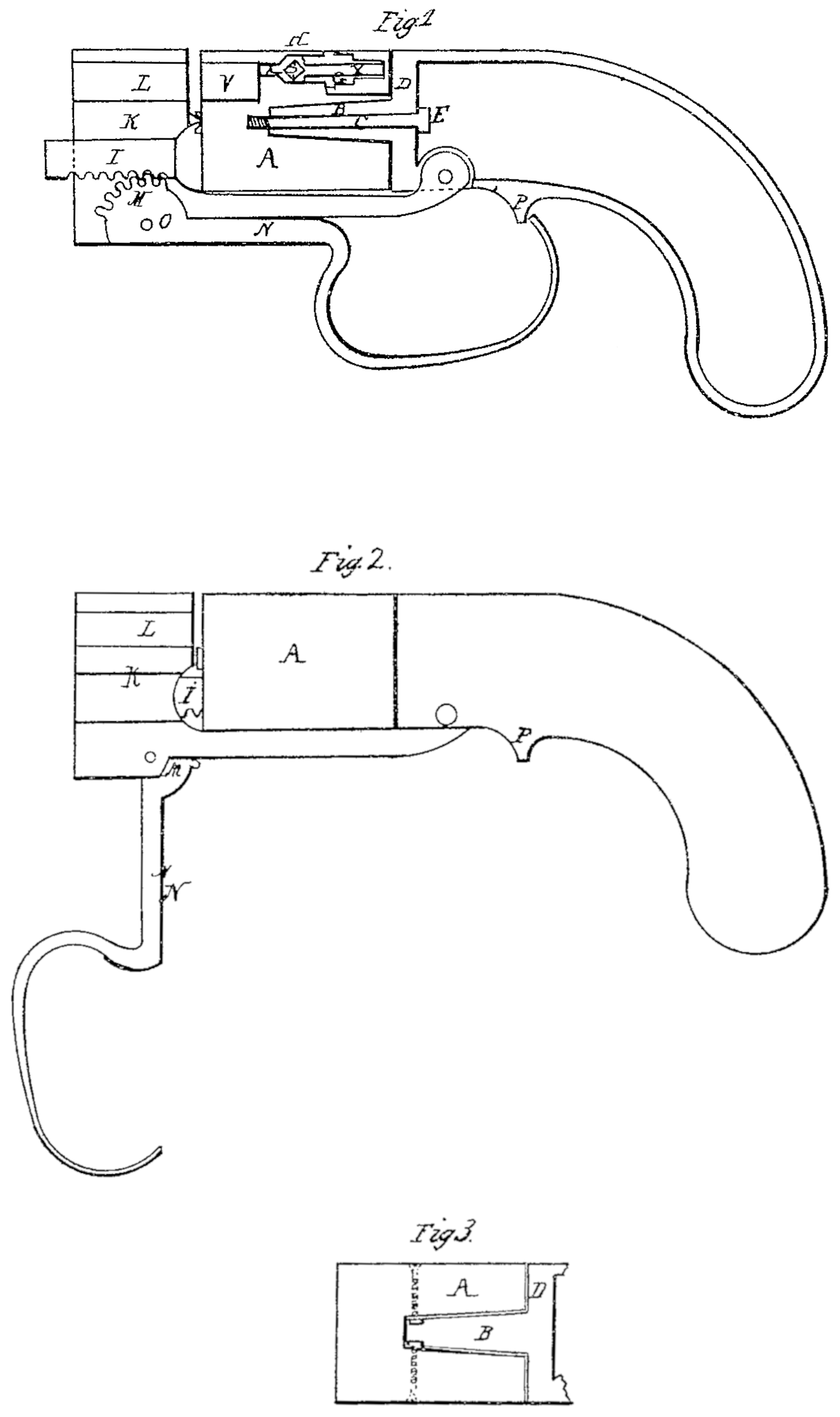US 16367
UNITED STATES PATENT OFFICE.
ETHAN ALLEN, OF WORCESTER, MASSACHUSETTS.
IMPROVEMED FIRE-ARM.
Specification forming part of Letters Patent No. 16,867, dated January 13, 1857.
To all whom it may concern:
Be it known that I, Ethan Allen, of the city and county of Worcester, and State of Massachusetts, have invented a new and useful Improvement in Fire-Arms; and I do hereby declare that the following is a full, clear, and exact description of the construction and operation of the same, reference being had to the accompanying drawings by the letters of reference marked thereon, in which drawings—
Figure 1 shows a section of the improved parts. Fig. 2 is an external side view with the guard-lever and rammer in operative position. Fig. 3 shows a variation in the manner of connecting the parts.
The same letters refer to the same parts in all.
My improved fire-arm is of that class known as “revolvers” or “repeating fire-arms,” and is constructed as follows: In the revolving piece A (see drawings) make a conical or ta per hole to fit the projection B, which is made tapering and solid with the back plate, D, and extends far enough to give sufficient bearing to support the revolving chambers or barrel A steadily, and through which passes the screw C, with its head. E on the inside, and, screwing into A firmly, turns with it, holding it on, and yet leaving it perfectly free to revolve. The passage X from the chamber V to the nipple G. is made large and with a cavity at the base of the nipple G, in which is placed the conical valve-piece H, which is made with a smooth conical surface toward the nipple, whose aperture at the base is beveled to fit it, and the face of H toward the chambers is made fluted; or the edge of the hole may be fluted, the valve H being free in the cavity to play against either aperture, as the case may require. The rammer I, which is placed in the piece K, supporting the barrel L, is made with teeth in one side, in which work cogs on the segment M, made on the end of the guard-lever N and turning on a pin at O, the other end of the lever N -catching over the projection P to hold it in place When not Working the rammer.
The other parts (not described) may be of most any of the usual forms of construction, i merely adapting them to those described ; or those described may be adapted to other forms, only preserving their capability to perform certain functions in their operation, as follows:
The support B, being conical, can be made larger at its base than if straight, and affords great facility in fitting the chambers on it snug, yet free to turn, and allows the cavity for the valve H to be made without weakening the body of A materially, and makes a firm support for A, whereby I am enabled to use a long lever, N, and give great force to the rammer I with but little effort of the hand, the lever taking the position shown in Fig. 2 when the rammer is forced down. The force of the explosion of the cap on the nipple is sufficient to force the valve H toward the aperture leading to the chambers, and thus the fire passes out of the base of the nipple G and round the valve H, the fluting of the other side of the valve forming passages for it to pass to ignite the charge in the chamber, which, when exploding, forces back the valve against the nipple, thus closing the Vent and preventing any escape of gas or loss of force of the charge or burning out of the nipple.
Instead of the screw C running through B, the end of B may be made smaller and have a collar fitted on it, as in Fig. 3, and a screw or screws pass through the sides of A to hold it on, or a groove be used instead of a collar, the important features of B being its being solid or firmly attached to D, securing stiffness and perfection of fit to A.
What I claim as new, and desire to secure by Letters Patent, is—
1. Placing the valve II in the chamber at the base of the nipple, when constructed and operating substantially as above described.
2. Supporting and retaining the chambers A by the parts B, D, and C, when constructed and operating substantially as above set forth.
3. Operating the rammer by means of the lever N, said lever forming a guard for the trigger, as above described.
In testimony whereof I have hereunto to set my hand in the presence of two witnesses.
ETHAN ALLEN.
Witnesses:
Benjamin Arnold,
Chas, G. Arnold.

